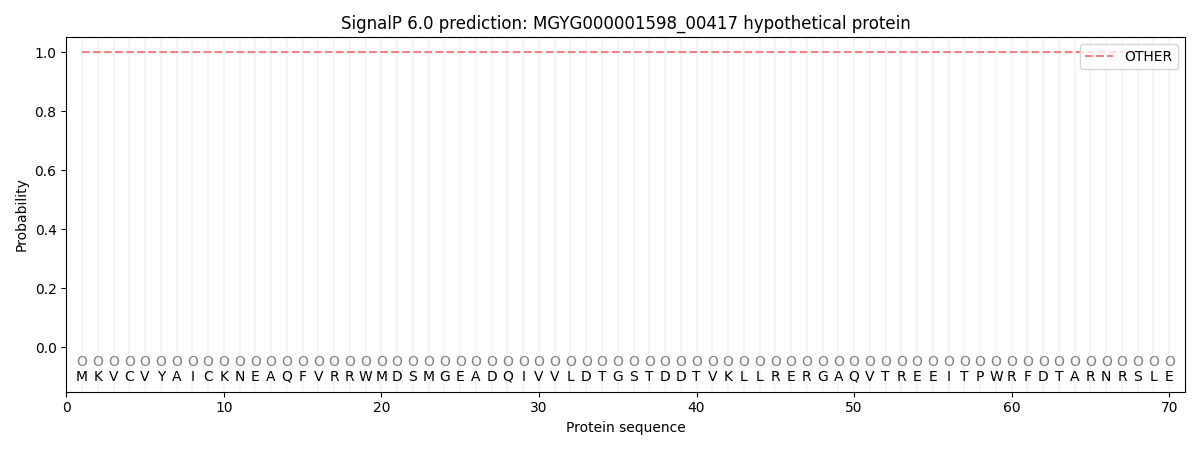You are browsing environment: HUMAN GUT
CAZyme Information: MGYG000001598_00417
You are here: Home > Sequence: MGYG000001598_00417
Basic Information |
Genomic context |
Full Sequence |
Enzyme annotations |
CAZy signature domains |
CDD domains |
CAZyme hits |
PDB hits |
Swiss-Prot hits |
SignalP and Lipop annotations |
TMHMM annotations
Basic Information help
| Species | Lawsonibacter sp900553135 | |||||||||||
|---|---|---|---|---|---|---|---|---|---|---|---|---|
| Lineage | Bacteria; Firmicutes_A; Clostridia; Oscillospirales; Oscillospiraceae; Lawsonibacter; Lawsonibacter sp900553135 | |||||||||||
| CAZyme ID | MGYG000001598_00417 | |||||||||||
| CAZy Family | GT2 | |||||||||||
| CAZyme Description | hypothetical protein | |||||||||||
| CAZyme Property |
|
|||||||||||
| Genome Property |
|
|||||||||||
| Gene Location | Start: 27211; End: 28290 Strand: - | |||||||||||
Full Sequence Download help
| MKVCVYAICK NEAQFVRRWM DSMGEADQIV VLDTGSTDDT VKLLRERGAQ VTREEITPWR | 60 |
| FDTARNRSLE LVPQDVDICV CTDLDEVFHP GWRRALEAAW RPGTGQARYR YTWSFNPDGS | 120 |
| EGVVFWYEKI HARRGYRWVH PVHEVLEWVG EGEPGPFVRV EGVQLDHHPD PSKSRAQYLE | 180 |
| LLELSVREAP QDDRNLHYLG REYLFRGRWE ECICTLKAHL ALPSATWRDE RAASMRYLGC | 240 |
| AYEQLGETGE AESWYLRAIA EAPHLREPWV DLAMLCYRRE DWEGVRWFTG RALAIEKRPE | 300 |
| TYICQAQAWG SLPWDLRALA LYHTGELEQA LAAARKALEL EPGNARLRDN VRLMEKLET | 359 |
CDD Domains download full data without filtering help
| Cdd ID | Domain | E-Value | qStart | qEnd | sStart | sEnd | Domain Description |
|---|---|---|---|---|---|---|---|
| cd02511 | Beta4Glucosyltransferase | 3.72e-14 | 2 | 169 | 1 | 165 | UDP-glucose LOS-beta-1,4 glucosyltransferase is required for biosynthesis of lipooligosaccharide. UDP-glucose: lipooligosaccharide (LOS) beta-1-4-glucosyltransferase catalyzes the addition of the first residue, glucose, of the lacto-N-neotetrase structure to HepI of the LOS inner core. LOS is the major constituent of the outer leaflet of the outer membrane of gram-positive bacteria. It consists of a short oligosaccharide chain of variable composition (alpha chain) attached to a branched inner core which is lined in turn to lipid A. Beta 1,4 glucosyltransferase is required to attach the alpha chain to the inner core. |
| sd00006 | TPR | 3.92e-09 | 232 | 339 | 1 | 97 | Tetratricopeptide repeat. The Tetratricopeptide repeat (TPR) typically contains 34 amino acids and is found in a variety of organisms including bacteria, cyanobacteria, yeast, fungi, plants, and humans. It is present in a variety of proteins including those involved in chaperone, cell-cycle, transcription, and protein transport complexes. The number of TPR motifs varies among proteins. Those containing 5-6 tandem repeats generate a right-handed helical structure with an amphipathic channel that is thought to accommodate an alpha-helix of a target protein. It has been proposed that TPR proteins preferentially interact with WD-40 repeat proteins, but in many instances several TPR-proteins seem to aggregate to multi-protein complexes. |
| COG0463 | WcaA | 2.55e-08 | 1 | 99 | 3 | 107 | Glycosyltransferase involved in cell wall bisynthesis [Cell wall/membrane/envelope biogenesis]. |
| sd00006 | TPR | 4.87e-08 | 196 | 283 | 4 | 86 | Tetratricopeptide repeat. The Tetratricopeptide repeat (TPR) typically contains 34 amino acids and is found in a variety of organisms including bacteria, cyanobacteria, yeast, fungi, plants, and humans. It is present in a variety of proteins including those involved in chaperone, cell-cycle, transcription, and protein transport complexes. The number of TPR motifs varies among proteins. Those containing 5-6 tandem repeats generate a right-handed helical structure with an amphipathic channel that is thought to accommodate an alpha-helix of a target protein. It has been proposed that TPR proteins preferentially interact with WD-40 repeat proteins, but in many instances several TPR-proteins seem to aggregate to multi-protein complexes. |
| TIGR02917 | PEP_TPR_lipo | 5.36e-08 | 198 | 345 | 95 | 227 | putative PEP-CTERM system TPR-repeat lipoprotein. This protein family occurs in strictly within a subset of Gram-negative bacterial species with the proposed PEP-CTERM/exosortase system, analogous to the LPXTG/sortase system common in Gram-positive bacteria. This protein occurs in a species if and only if a transmembrane histidine kinase (TIGR02916) and a DNA-binding response regulator (TIGR02915) also occur. The present of tetratricopeptide repeats (TPR) suggests protein-protein interaction, possibly for the regulation of PEP-CTERM protein expression, since many PEP-CTERM proteins in these genomes are preceded by a proposed DNA binding site for the response regulator. |
CAZyme Hits help
| Hit ID | E-Value | Query Start | Query End | Hit Start | Hit End |
|---|---|---|---|---|---|
| QIA29496.1 | 5.33e-176 | 1 | 351 | 1 | 351 |
| ANU42689.1 | 1.53e-175 | 1 | 351 | 1 | 351 |
| QQR04409.1 | 1.53e-175 | 1 | 351 | 1 | 351 |
| AQS58818.1 | 9.36e-146 | 1 | 355 | 4 | 357 |
| CAB1239995.1 | 4.68e-145 | 2 | 356 | 5 | 358 |
Swiss-Prot Hits download full data without filtering help
| Hit ID | E-Value | Query Start | Query End | Hit Start | Hit End | Description |
|---|---|---|---|---|---|---|
| Q9XC90 | 3.78e-07 | 2 | 96 | 4 | 95 | Lipopolysaccharide core biosynthesis glycosyltransferase WaaE OS=Klebsiella pneumoniae OX=573 GN=waaE PE=3 SV=1 |
SignalP and Lipop Annotations help
This protein is predicted as OTHER

| Other | SP_Sec_SPI | LIPO_Sec_SPII | TAT_Tat_SPI | TATLIP_Sec_SPII | PILIN_Sec_SPIII |
|---|---|---|---|---|---|
| 1.000062 | 0.000000 | 0.000000 | 0.000000 | 0.000000 | 0.000000 |
